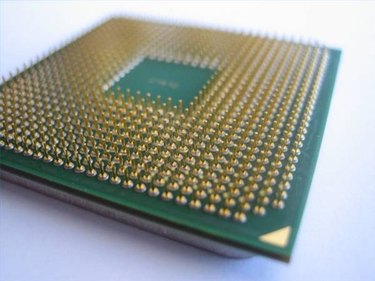
A microprocessor, or central processing unit (CPU), is an internal hardware component that performs the mathematical calculations required for computers to run programs and execute commands. Processors are usually made of silicon material that contains tiny electrical components embedded on the surface. Typical computer programs that must be processed by CPUs include Internet browsers, games and video editing software.
Arithmetic Logic Unit
Video of the Day
Arithmetic logic units (ALUs) in microprocessors allow computers to add, subtract, multiply, divide and perform other logical operations at high speeds. Thanks to advanced ALUs, modern microprocessors and GPUs (graphics processing units) are able to perform very complicated operations on large floating-point numbers.
Video of the Day
Cache Memory
Cache memory is an area on the CPU where copies of common instructions required to perform functions and run programs are stored temporarily. Since the processor has its own smaller, faster cache memory, it can process data more quickly than reading and writing to the main system memory. Types of microprocessor memory include ROM (read-only) and RAM (random-access).
Transistors
Basically, transistors are semiconductor devices used to switch electronic signals. In microprocessors, a higher number of transistors means a better performing CPU. For example, Intel Pentium 4 processors have around 40 to 50 million transistors, while older Pentium 3 CPUs have 9.5 million. More transistors allow for pipelining and multiple instructions decoders, which allows several processes to be completed during every clock cycle.
Control Signals
Control signals are electronic signals that control the processor components being used to perform an operation or execute an instruction. An element called a "sequencer" sends control signals to tell the specific unit what it needs to do next. For example, a read or write signal may be sent to the cache memory letting it know that the processor is getting ready to read or write data into processor memory.
Instruction Set and Registers
The group of instructions a processor can execute are called its "instruction set." The instruction set determines things such as the type of programs a CPU can work with. Registers are small memory locations that also contain instructions. Unlike regular memory locations, registers are referred to by a name instead of a number. For example, the IP (instruction pointer) contains the location of the next instruction, and the "accumulator" is where the processor stores the next value it plans to work on.